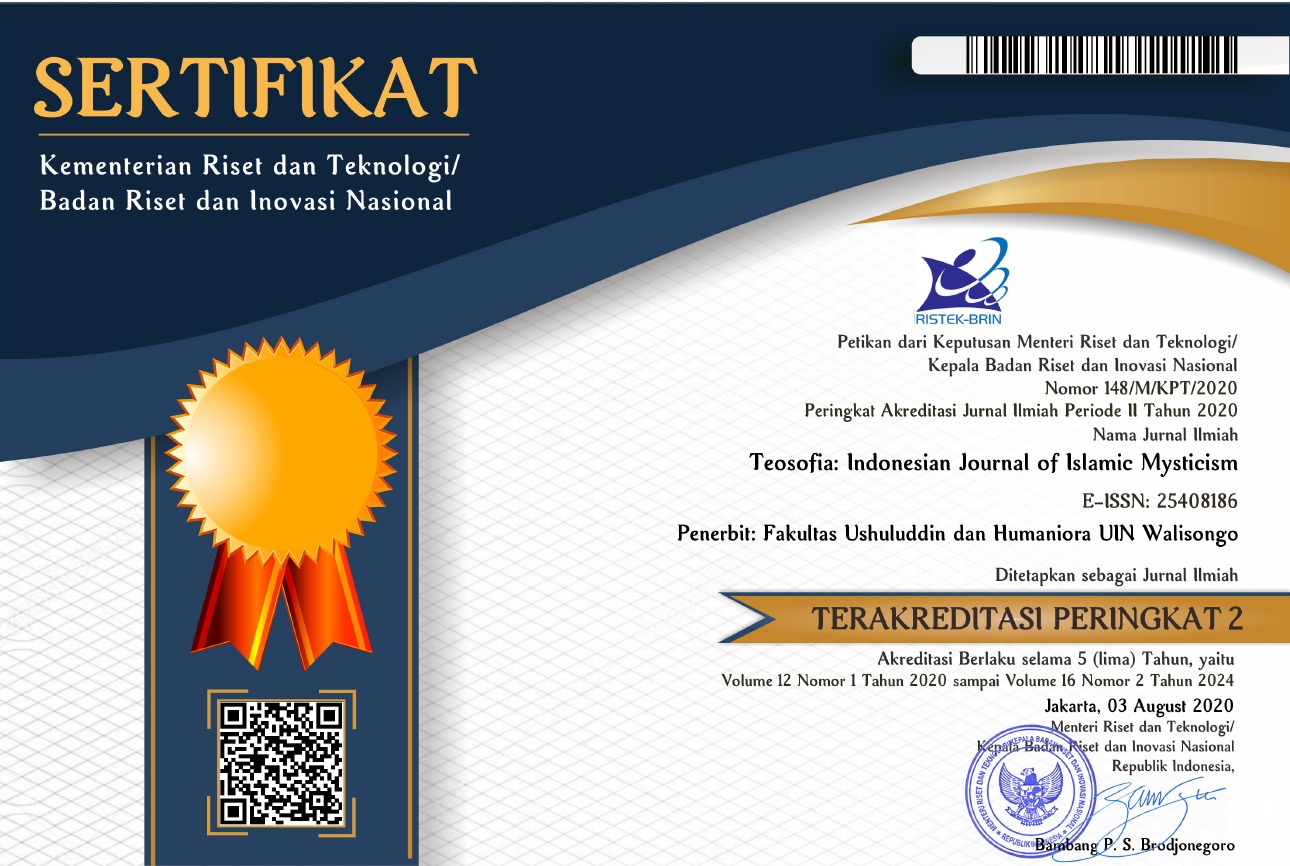Becoming a Meaningful Human in The Contemporary Era: Isyari's Interpretation of Human Fiṭrah in Risālah Al-Nūr According to Said Nursi
DOI:
https://doi.org/10.21580/tos.v9i2.7332Keywords:
Human Nature, Human Meaningfulness, Outer-inner Senses, Tafsir Isyāri, Said Nursi.Abstract
This paper wants to prove how Said Nursi's efforts to persuade humans to become meaningful (ma’nawi) humans through his interpretation of Risālah al-Nūr. This tafsir, which is more Kalam and Isyāri (Sufi) in style, was Nursi's answer to his anxiety in facing the challenges of modernity in Turkey at that time (and is still relevant today). In the context of human nature, Nursi is aware that modernity has made humans fall into an attitude which he calls tafrid and ifrat in using his every senses (outer and inner senses). Therefore, with the characteristics and originality of his interpretation, he describes how people can return to their nature, namely by behaving 'adl or tawasut in all things. This is the man that he later calls as a meaningful human being. The methods that the author used in this research are descriptive-analysis methods and library research, by making tafsir Risālah al-Nūr and tafsir Isyārāt al-I’jāz as primary sources, then supported by other secondary books which are still related to the theme.
Downloads
References
Abduh, Muhammed. El-A’mālü’l-Kāmile, n.d.
———. Risāletü’t-Tevḥīd. Edited by M. Reşīd Rızā. Kahire, 1947.
———. Tefsīru Cüzʾi ʿAmme. Mesir: Maṭbaatu’ş-Şa’b, n.d.
Al-Ġazzālī, Abū Ḥāmid. El-Ḥikme Fî Maḫlūḳāti’llâh. Edited by Muhammed Reşid Kabbani. Beyrut: Dari İhyai’l-Ulum, 1986.
———. El-Münḳıẕ Mine’ḍ-Ḍalâl. Edited by Ǧamīl Ṣalībā and Kāmil Ayyād. Beyrut: Dār al-ʾAndalus, 1973.
———. Eyyühe’l-Veled. Bağdad, 1968.
———. Iḥyāʼ ʻulūm Al-Dīn. Vol. III. Leiden: Brill, 1963.
———. Kimyayi Saadet. Istanbul: Celik Yayinevi, 1996.
———. Mîzânü’l-ʿamel. Edited by Süleyman Dünya. Kahire: Dârü’l-Meârif, 1964.
———. Miʿyārü’l-ʿilm. Edited by Hasan Hacak. Translated by Ali Durusoy. Istanbul: Türkiye Yazma Eserler Kurumu Başkanlığı, 2013.
Aristotales. ’İlmü’l-Akhlāḳ. Translated by A. Lütfi Es-Seyyid. Kahire, 1924.
Bedevī, Abdurrahman. Müʾellefâtü’l-Ġazzālī. Küveyt, 1977.
Coruh, Hakan. Modern Interpretation of The Qur’an: The Contribution of Badi’uzzaman Said Nursi. Switzerland: Springer, 2019.
Eflātun. Devlet. Translated by Sabahattin Eyüboğlu and M. Ali Cimcoz. Istanbul, 1985.
el-Hâkim en-Neysâbûrî, Muhammed b. Abdillah Ebu Abdillah. El-Müstedrek Ale’s-Sahîhayn. Beyrut: Dâru’l-kütübi’l-ilmiyye, 1990.
El-Münziri, Muhammed Zekiyuddin. Et-Terğib ve’t-Terhib. Beyrut: ei-Mektebetu’l-Asnyye, 1996.
Er-Rāzī, Fahreddin. Mefātīḥu’l-Ġayb. Beirut: Dar al-Fikr, 1981.
Farābī. El-Medīnetü’l-Fāżıla. Translated by A. Nader. Beyrut, 1986.
———. El-Medīnetü’l-Fāżıla. Kahire: Matbaatü’n-Nīl, 1968.
———. Es-Siyāsetü’l-Medeniyye. Haydarābād, 1927.
———. Et-Tenbīh ʿalā Sebīli’s-Saʿāde. Haydarābād, 1927.
———. Fuṣûlün Müntezeʿa. Translated by Mâcid Fahrî. Vol. II. Beyrut, 1978.
———. Meʿāni’l-ʿaḳl. Translated by Friedrich Dieterici. Leiden: E.J. Brill, 1895.
———. Taḥṣīlü’s-Saʿāde. Edited by Ca‘fer Âlüyâsîn. Beyrut, 1983.
———. Taḥṣīlü’s-Saʿāde. Haydarābād, 1926.
Hamsah, Ustadi. “Membaca Pemikiran Bediuzzaman Said Nursi Tentang Signifikansi Agama Dan Identitas Bagi Kemajuan Sosial.” TEOSOFI: Jurnal Tasawuf Dan Pemikiran Islam 8, no. 2 (December 10, 2018): 351–72. https://doi.org/10.15642/teosofi.2018.8.2.293-314.
Haylamaz, Resid. “Islam’s Universality and the Risale-i Nur’s Method of Interpreting the Qur’an’s Universality.” TSAQAFAH 10, no. 2 (November 30, 2014): 245–78. https://doi.org/10.21111/tsaqafah.v10i2.188.
Horkuc, Hasan. “New Muslim Discourses on Pluralism in the Post-Modern Age.” American Journal of Islam and Society 19, no. 2 (April 1, 2002): 68–86. https://doi.org/10.35632/ajis.v19i2.1971.
Kuru, Zeynep Akbulut, and Ahmet T. Kuru. “Apolitical Interpretation of Islam: Said Nursi’s Faith-Based Activism in Comparison with Political Islamism and Sufism.” Islam and Christian–Muslim Relations 19, no. 1 (January 21, 2008): 99–111. https://doi.org/10.1080/13510340701770311.
Markham, Ian S. “The Qur’an Revealed: A Critical Analysis of Said Nursi’s Epistles of Light, ColinTurner, Gerlach Press, 2013.” Reviews in Religion & Theology 22, no. 3 (2015): 281–83. https://doi.org/10.1111/rirt.12529.
Markham, Ian S., Suendam Birinci Pirim, and Said Nursî. An Introduction to Said Nursi: Life, Thought and Writings. Farnham, Surrey; Burlington, VT: Ashgate, 2011.
Menek, Abdulkadir. Bediüzzaman Said Nursi İstanbul Hayati. Istanbul: Yeni Asya Neşriyat, 2008.
Nursi, Said. Isaratul Ijaz. Istanbul: Sözler Yayınevi, 2014.
———. Isyārāt Al-I’jāz Fi Madzan Al-Ijaz. 3rd ed. Kairo: Dar al-Kutub al-Misriyyah, 2002.
———. Lemalar. Istanbul: Altinbasak, 2008.
———. Maktubat. Istanbul: Altinbasak, 2012.
———. Munazarat. Istanbul: Fayyaz Yayinlari, 2006.
———. Sozler. Istanbul: Altinbasak, 2009.
———. Tarihçe-i Hayat. Istanbul: Feyyaz Yayinlari, 2006.
Osman, Rahmah Bt. Ahmad H. “Imam Bediüzzaman Said Nursi’s Concept of Tolerance as a Pillar of Moderation and Unity.” The Journal of Risale-i Nur Studies 1, no. 1 (2018): 17–32.
Rahman, Fazlur. “Concepts Sunnah, Ijtihād and Ijmāʾ in the Early Period.” Islamic Studies 1, no. 1 (1962): 5–21.
———. “Divine Revelation and the Prophet.” Hamdard Islamicus 2, no. 1 (1978): 66–72.
———. Islam. Chicago: University of Chicago Press, 1982.
———. Islam and Modernity. Chicago: University of Chicago Press, 1982.
———. Islamic Methodology in History. Karachi: Central Institute of Islamic Research, 1965.
———. “The Post Formative Development in Islam.” Islamic Studies 4, no. 1 (1962).
Rızā, Reşīd. Tarikh Al-Ustadz Imam Shekh Muhammad Abduh. Vol. I. Cairo: Dar al-Manar, 1931.
Robson, James. “Tradition, the Second Foundation of Islam.” The Muslim World 41, no. 1 (January 1951): 22–33. https://doi.org/10.1111/j.1478-1913.1951.tb02505.x.
Safâ, İhvân-ı. Er-Resâʾil. Edited by Butrus El-Bustânî. Beyrut, 1957.
Şahyar, Ayşe Esra Ağırakça. “Zayıf Hadisle Fezâil Konusunda Amel Edilebilirlik’ Fikrinin Doğuşu ve Gelişimi.” Hadis Tetkikleri Dergisi 1, no. 1 (2003): 31–49.
Shihab, Quraish. Kaidah Tafsir. 3rd ed. Tangerang: Lentera Hati, 2015.
Sīnā, Ibn. ’İlmü’l-Aḫlāḳ. Kahire: Mecmaʿu’r-resāʾil içinde, 1908.
———. Eş-ŞifâʾI: El-İlāhiyyāt. Edited by İbrāhim Medkūr. Kahire, 1924.
Sīnā, İbn. En-Necât. Edited by Muhammed Takī Dânişpejûh. Tehran, 1985.
Sühreverdî. Awārifu-l-Maʿārif. Viçinde, n.d.
Tehdzībü’l-aḫlāḳ. İbn Miskeveyh. Edited by Hasan Temîm. Beyrut, 1977.
Teymiyye, Takıyyüddin Ahmed b. Abdülhalīm b. Mecmûʿu Fetāvā. Edited by Abdurrahman b. Muhammed. Vol. I–XXXVII. Riyadh, 1991.
Vahide, Sukran. Biografi Intelektual Badiuzzaman Said Nursi: Transformasi Dinasti Ustmani Menjadi Republik Turki. Edited by Nur Rofiah. Translated by Sugeng Haryanto and Sukono. Jakarta: Anatolia, 2013.
Zeyne, Hüsnī. El-ʿAḳl ʿinde’l-Muʿtezile. Beyrut, 1978.
Downloads
Published
How to Cite
Issue
Section
License
Copyright
The copyright of the received article shall be assigned to the journal as the publisher of the journal. The intended copyright includes the right to publish the article in various forms (including reprints). The journal maintains the publishing rights to the published articles. Therefore, the author must submit a statement of the Copyright Transfer Agreement.*)
Licensing

This work is licensed under a Creative Commons Attribution-ShareAlike 4.0 International License.
In line with the license, authors are allowed to share and adapt the material. In addition, the material must be given appropriate credit, provided with a link to the license, and indicated if changes were made. If authors remix, transform or build upon the material, authors must distribute their contributions under the same license as the original.
_______
*) Authors whose articles are accepted for publication will receive confirmation via email and send a Copyright Transfer Agreement.








